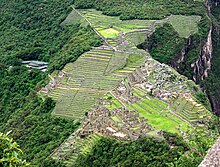The Incas started building the estate around AD 1400 but abandoned it as an official site for the Inca rulers a century later at the time of the Spanish Conquest. Although known locally, it was unknown to the outside world before being brought to international attention in 1911 by the American historian Hiram Bingham. Since then, Machu Picchu has become an important tourist attraction.
Since the site was never known to the Spanish during their conquest, it is highly significant as a relatively intact cultural site. Machu Picchu was declared a Peruvian Historical Sanctuary in 1981 and a UNESCO World Heritage Site in 1983. In 2007, Machu Picchu was voted one of the New Seven Wonders of the World in a worldwide Internet poll.
Machu Picchu was built in the classical Inca style, with polished dry-stone walls. Its three primary buildings are the Intihuatana, the Temple of the Sun, and the Room of the Three Windows. These are located in what is known by archaeologists as the Sacred District of Machu Picchu. In September 2007, Peru and Yale University almost reached an agreement regarding the return of artifacts which Yale has held since Hiram Bingham removed them from Machu Picchu in the early twentieth century. In November 2010, a Yale University representative agreed to return the artifacts to a Peruvian university.
Machu Picchu was built around 1450, at the height of the Inca Empire. It was abandoned just over 100 years later, in 1572, as a belated result of the Spanish Conquest. It is likely that most of its inhabitants died from smallpox introduced by travelers before the Spanish conquistadores arrived in the area. The latter had notes of a place called Piccho, although there is no record of the Spanish having visited the remote city. The types of sacred rocks defaced by the conquistadors in other locations are untouched at Machu Picchu.
Hiram Bingham theorized that the complex was the traditional birthplace of the Incan "Virgins of the Suns More recent research by scholars such as John Rowe and Richard Burger, has convinced most archaeologists that Machu Picchu was an estate of the Inca emperor Pachacuti. In addition, Johan Reinhard presented evidence that the site was selected because of its position relative to sacred landscape features such as its mountains, which are purported to be in alignment with key astronomical events important to the Incas.
Another theory maintains that Machu Picchu was an Inca llaqta, a settlement built to control the economy of conquered regions. Yet another asserts that it may have been built as a prison for a select few who had committed heinous crimes against Inca society. An alternative theory is that it is an agricultural testing station. Different types of crops could be tested in the many different micro-climates afforded by the location and the terraces; these were not large enough to grow food on a large scale, but may have been used to determine what could grow where. Another theory suggests that the city was built for the gods to live in, or for the coronation of kings.
As Pachacuti conquered new territory, he built settlements and connected them with a web of roads. Machu Picchu was the largest and most magnificent of all these communities. It was not a fortress, but the sight of it looming high above the Urubamba valley may have intimidated the lowland rain forest tribes who were hostile to the Incas.
Although the citadel is located only about 80 kilometers (50 miles) from Cusco, the Inca capital, the Spanish never found it and consequently did not plunder or destroy it, as they did so many other sites. Over the centuries, the surrounding jungle grew over much of the site, and few outsiders knew of its existence.
On 24 July 1911, Hiram Bingham announced the find of Machu Picchu to scholars. An American historian employed as a lecturer at Yale University, Bingham had been searching for the city of Vilcabamba, the last Inca refuge during the Spanish conquest. He had worked for years in previous trips and explorations around the zone. Pablito Alvarez, a local 11 year-old Quechuas boy, led Bingham up to Machu Picchu. Some Quechuas lived in the original structures at Machu Picchu.
Bingham started archaeological studies and completed a survey of the area. He called the complex "The Lost City of the Incas", which was the title of his first book. Bingham made several more trips and conducted excavations on the site through 1915, collecting various artifacts which he took back to Yale. He wrote a number of books and articles about the discovery of Machu Picchu.
The site received significant publicity after the National Geographic Society devoted their entire April 1913 issue to Machu Picchu.
In 1981 Perus declared an area of 325.92 square kilometers surrounding Machu Picchu as a "Historical Sanctuary". In addition to the ruins, the sanctuary includes a large portion of the adjoining region, rich with flora and fauna.
In 1983 UNESCO designated Machu Picchu a World Heritage Site, describing it as "an absolute masterpiece of architecture and a unique testimony to the Inca civilization.
The World Monuments Fund placed Machu Picchu on its 2008 Watch List of the 100 Most Endangered Sites in the world because of environmental degradation. This has resulted from the impact of tourism, uncontrolled development in the nearby town of Aguas Calientes, which included a poorly sited tram to ease visitor access, and the construction of a bridge across the Vilcanota River, which is likely to bring even more tourists to the site, in defiance of a court order and government protests against it.

The Geographic issue is available at shigitatsu.com
ReplyDelete